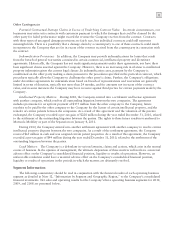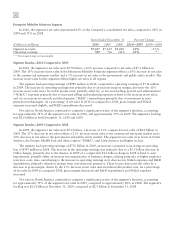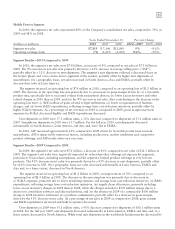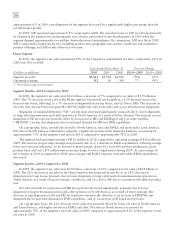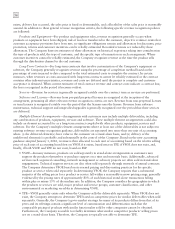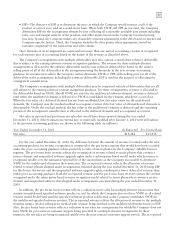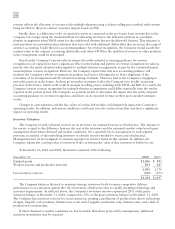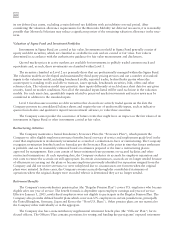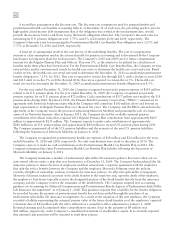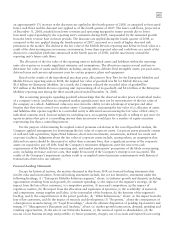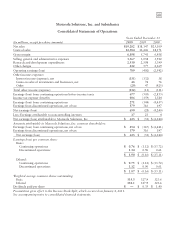Motorola 2010 Annual Report Download - page 68
Download and view the complete annual report
Please find page 68 of the 2010 Motorola annual report below. You can navigate through the pages in the report by either clicking on the pages listed below, or by using the keyword search tool below to find specific information within the annual report.
60
its net deferred tax assets, excluding certain deferred tax liabilities with an indefinite reversal period. After
considering the valuation allowance requirements for the Motorola Mobility net deferred tax assets, it is reasonably
possible that Motorola Solutions may reduce a significant portion of the remaining valuation allowance in the near-
term.
Valuation of Sigma Fund and Investment Portfolios
Investments in Sigma Fund are carried at fair value. Investments not held in Sigma Fund generally consist of
equity and debt securities, which are classified as available-for-sale and are carried at fair value. Fair value is
determined in accordance with the authoritative guidance for fair value measurement and disclosures.
Quoted market prices in active markets are available for investments in publicly traded common stock and
equivalents and, as such, these investments are classified within Level 1.
The securities classified as Level 2 are primarily those that are professionally managed within the Sigma Fund.
The valuation models are developed and maintained by third-party pricing services and use a number of standard
inputs to the valuation model, including benchmark yields, reported trades, broker/dealer quotes where the
counterparty is standing ready and able to transact, issuer spreads, benchmark securities, bids, offers and other
reference data. The valuation model may prioritize these inputs differently at each balance sheet date for any given
security, based on market conditions. Not all of the standard inputs listed will be used each time in the valuation
models. For each asset class, quantifiable inputs related to perceived market movements and sector news may be
considered in addition to the standard inputs.
Level 3 fixed income securities are debt securities that do not have actively traded quotes on the date the
Company presents its consolidated balance sheets and require the use of unobservable inputs, such as indicative
quotes from dealers and qualitative input from investment advisors, to value these securities.
The Company cannot predict the occurrence of future events that might have an impact on the fair values of its
investments in Sigma Fund or other investments carried at fair value.
Restructuring Activities
The Company maintains a formal Involuntary Severance Plan (the “Severance Plan”), which permits the
Company to offer eligible employees severance benefits based on years of service and employment grade level in the
event that employment is involuntarily terminated as a result of a reduction-in-force or restructuring. The Company
recognizes termination benefits based on formulas per the Severance Plan at the point in time that future settlement
is probable and can be reasonably estimated based on estimates prepared at the time a restructuring plan is
approved by management. Exit costs consist of future minimum lease payments on vacated facilities and other
contractual terminations. At each reporting date, the Company evaluates its accruals for employee separation and
exit costs to ensure the accruals are still appropriate. In certain circumstances, accruals are no longer needed because
of efficiencies in carrying out the plans or because employees previously identified for separation resigned from the
Company and did not receive severance or were redeployed due to circumstances not foreseen when the original
plans were initiated. In these cases, the Company reverses accruals through the consolidated statements of
operations where the original charges were recorded when it is determined they are no longer needed.
Retirement Benefits
The Company’s noncontributory pension plan (the “Regular Pension Plan”) covers U.S. employees who became
eligible after one year of service. The benefit formula is dependent upon employee earnings and years of service.
Effective January 1, 2005, newly-hired employees were not eligible to participate in the Regular Pension Plan. The
Company also provides defined benefit plans which cover non-U.S. employees in certain jurisdictions, principally
the United Kingdom, Germany, Japan and Korea (the “Non-U.S. Plans”). Other pension plans are not material to
the Company either individually or in the aggregate.
The Company also has a noncontributory supplemental retirement benefit plan (the “Officers’ Plan”) for its
elected officers. The Officers’ Plan contains provisions for vesting and funding the participants’ expected retirement



